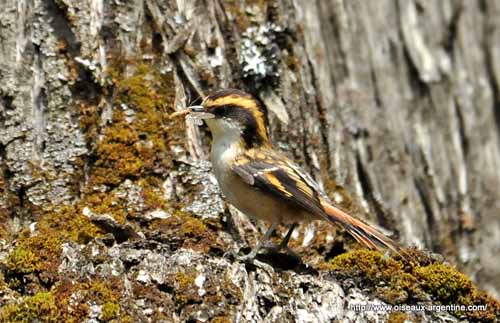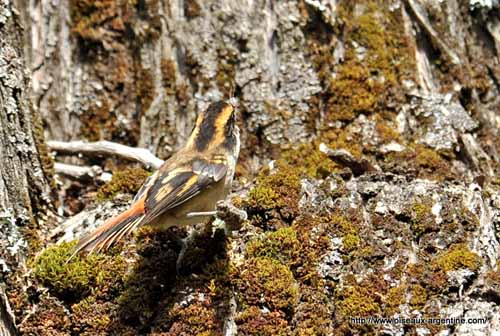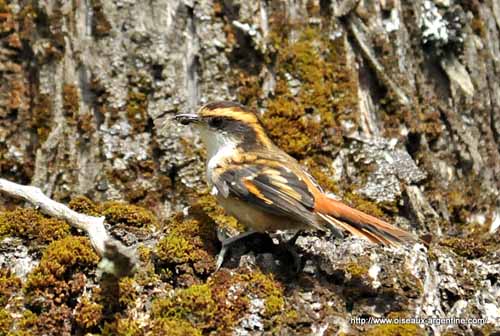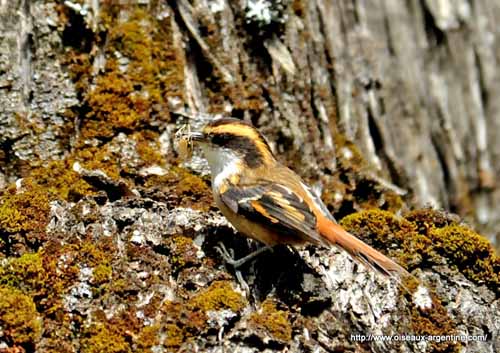
Fr: Synallaxe rayadito
All : Festland-Stachelschwanzschlüpfer
Esp: Rayadito Común
Esp (Argentine & Chili): Rayadito
Ital: Rayadito codaspinosa
Nd: Doornstaartrayadito
Sd: Rayadito
Photographers :
Philippe et Aline Wolfer
GALERIE
Text by Nicole Bouglouan
Sources :
HANDBOOK OF THE BIRDS OF THE WORLD Vol 8 By Josep del Hoyo-Andrew Elliott-David Christie - Lynx Edicions - ISBN: 8487334504
BIRDS OF SOUTH AMERICA – Passerines - by Robert S. Ridgely and Guy Tudor – HELM Field Guides – ISBN: 9781408113424
BirdLife International (BirdLife International)
Arthur Grosset's Birds (Arthur Grosset)
Wikipedia, the free encyclopaedia
Thorn-tailed Rayadito
Aphrastura spinicauda
Passeriforme Order – Furnariidae Family
BIOMETRICS:
Length: 13-14 cm
Weight: 10-13 gr
DESCRIPTION:
This small, active Furnariidae species is a common bird in Chile and Argentina.
The adult of nominate race has black head with long, broad, buff-orange supercilium from forehead to nape and upper back. Chin and throat are whitish.
The upperparts are brown, becoming rufous-chestnut on rump and uppertail-coverts. The tail is strongly graduated, with narrow protruding shafts without barbs, involving very “spiny” appearance. The colour pattern is complex, a mix of black, brown, chestnut and rufous. The tail is probably used as a brace during climbing.
The upperwing shows black wing-coverts, with medians tipped and edged rufous and greaters tipped whitish. On closed wings, the pattern is mainly black with prominent buff markings due to orange-rufous bases and buffy-brown band across flight feathers.
The underparts are whitish with white chin and throat, and dull buffy breast and belly. Body sides are pale brownish, with more rufous flanks and undertail-coverts.
The bill is blackish. The eyes are dark brown. Legs and feet are pale greyish.
Both sexes are similar. The juvenile is duller.

We can find three subspecies:
A.s. spinicauda (here described and displayed) is found in C and S Chile and extreme W Argentina, S to Tierra del Fuego, and offshore islands including the Falkland’s.
A.s. bullocki is found on Mocha Island, off SC Chile. This one resembles nominate race, with whitish throat and brownish-buff-tinged underparts.
A.s. fulva is found on Chiloe Island, off SC Chile. It has ochraceous underparts with paler throat.
VOICE: SOUNDS BY XENO-CANTO
The Thorn-tailed rayadito utters various calls, but the commonest is a short, dry “trrrrrreet”. This sound may sometimes be protracted and interspersed by “tic” notes. We can also hear high-pitched “tsii-tsii-tsii-tsii…” and a metallic “ti-ti”.

HABITAT:
The Thorn-tailed Rayadito is usually common in a variety of forested and wooded habitats, but it also frequents arid lowlands scrub locally. On islands, it can be found in tussock grass or shrubs. This species is visible from sea-level to 1200 metres, and locally up to 2000 metres of elevation.
RANGE:
See above in “subspecies”
BEHAVIOUR:
The Thorn-tailed Rayadito is an insect-eater, taking both Diptera and Hymenoptera. It also pecks ripe fruits. It is very active and forages at all levels in foliage, mosses and lichens, branches and tree trunks, often moving with cocked tail. It may occasionally forage on the ground.
It can be seen in pairs or in small groups of 5-7 birds, up to 15 sometimes. They gather in larger flocks outside the breeding season in the austral autumn and winter. Their behaviour is often described as similar to that of Paridae of N hemisphere.

The breeding behaviour of this species is poorly known. They nest in cavities, in trees and dead snags. The plumage pattern is probably enhanced by adapted postures during the displays, and the strongly graduated tail is cocked and fanned.
This species is resident in its range.
FLIGHT:
Like numerous Furnariidae species, the Thorn-tailed Rayadito has relatively short, rounded to slightly pointed wings reflecting its sedentary status and the absence of aerial foraging.

REPRODUCTION:
The breeding season occurs during the austral spring and summer, from October to January.
The Thorn-tailed Rayadito nests in cavities in trees, dead snags, behind loose bark or in crevice in the trunk, and sometimes under roofs. The nest is made with rootlets and stems of epiphytic vines and grasses. The interior is lined with feathers.
This species is monogamous.
The female lays 3-4 eggs. Both parents incubate during about two weeks. The chick’s growth occurs over three weeks. They are fed by adults with insects. Parents share all the nesting duties.
This species produces one or two broods per season.

DIET:
The Thorn-tailed Rayadito feeds primarily on arthropods, especially Diptera and Hymenoptera. It may peck ripe fruits of Berberis, Ribes and Gunnera.
It gleans from foliage, branches and trunks, from the understory to the canopy, and sometimes on the ground.
PROTECTION / THREATS / STATUS:
The Thorn-tailed Rayadito can be common to locally abundant in its range where there are only sparse human populations.
This species is not currently threatened.
